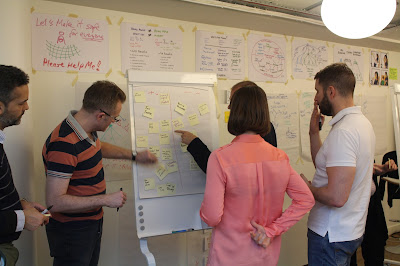This article presents a quick look at how one can determine if leaders of an organisation really want to Be Agile. Leaders can be the Heads of Departments or Leaders of Teams, or in this case Scrum Masters who lead the facilitation and coaching of the Team.
Problem:
So, if as an Agile Coach you have been asked in to discuss Agile Adoption with the Scrum Masters of a large department of a company. But how do you know if they really want to Be Agile?
Or is this just another tick box for senior management? Cloud, DevOps, Agile Methodology, Open Source etc.
Or is this just another tick box for senior management? Cloud, DevOps, Agile Methodology, Open Source etc.
Idea:
I recently attended the CAL1 [1] course by Michael Sahota [2]. If you have not been on this course you really should go, it was amazing and insightful. On this course Michael provided a Play-Book For Inviting Growth.
I adapted this play-book for determining if the leaders (in this case Scrum Masters) of an organisation really wanted to have an Agile Culture like so:
I adapted this play-book for determining if the leaders (in this case Scrum Masters) of an organisation really wanted to have an Agile Culture like so:
- Do you want to Grow your organisation and teams?
- If so, why do you want to Grow it? (Profits? Market share? Innovation? Best place to work?)
- Michael states to drop the word Agile as it has too many connotations (I am not so sure).
- Raise awareness Externally and Internally of the change coming. Coach the teams.
- Do you want to change Culture? If not then Tactical or Strategic is whats left.
- If you want Culture change you should orient towards a known Model (Teal, SDi, Sahota's model or for Scrum Master, Scrum of course!)
- Leaders must Go First on this journey or no one else will.
Number three may seem controversial but is Agile really the Goal? I still have my doubts.
Michael says ince we determine that the Goal is not Agile but another leadership reason then we can focus back on the real Goal. This leads us to an diagram from Michael on what is your focus for change?
 |
| What Is Your Focus? Micheal Sahota [3] |
As we can see from the diagram Tactical and Strategic benefits are at the top, but it is Culture which has the break through results. And Michael's model of what Culture looks like:
 |
| Culture Model Micheal Sahota [4] |
Finally Leaders must go first. And as we are all leaders in one shape or another we all learned a lot by being one of the first people to go on the CAL1 in the UK.
Here are some photos of my class that learned so much by going first!
Here are some photos of my class that learned so much by going first!
 |
| Micheal Sahota trains the CAL1 |
 |
| Group Discussion on Culture |
 |
| The Agile Hand of Stop Talking! |
 |
| Micheal takes us on another journey of learning! |
 |
| Which Metrics Work? Go on the CAL1 and find out! |
 |
| UK Class of Feb 2017 |
References:
[1] CAL1: https://www.scrumalliance.org/certifications/practitioners/agile-leadership/certified-agile-leadership-program
[2] Michael Sahota: http://agilitrix.com/moreagilitrix/
[3] What Is Your Focus?: http://agilitrix.com/2012/11/tactics-strategy-culture/
[2] Michael Sahota: http://agilitrix.com/moreagilitrix/
[3] What Is Your Focus?: http://agilitrix.com/2012/11/tactics-strategy-culture/
[4] Culture Model: http://agilitrix.com/culture/




















